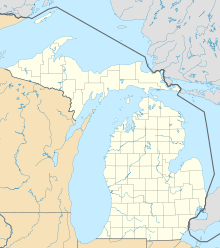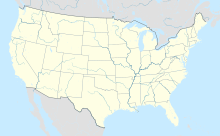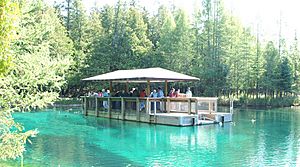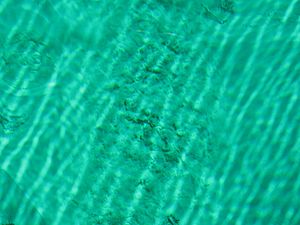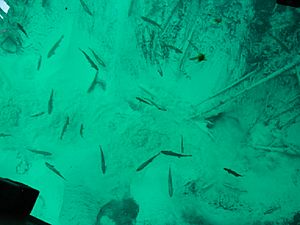Kitch-iti-kipi facts for kids
Quick facts for kids Kitch-iti-kipi |
|
|---|---|
| Big Spring | |

View of the Kitch-iti-kipi spring
|
|
| Location | Schoolcraft County, Michigan |
| Coordinates | 46°00′15″N 86°22′55″W / 46.00412°N 86.38201°W |
| Type | spring |
Kitch-iti-kipi (pronounced "KITCH-i-tee-KI-pee") is the biggest natural freshwater spring in Michigan. Its name comes from the Ojibwe language and means "big cold spring." People also call it the Big Spring. The Ojibwe people originally named it Kitch-iti-kipi, which today is often translated as "Mirror of Heaven."
This amazing spring is one of the most popular places to visit in Michigan's Upper Peninsula. You can find it in Thompson Township in Schoolcraft County. It's located northwest of the town of Manistique, inside Palms Book State Park. The state of Michigan received the spring and its land in 1926. The only condition was that it had to become a public park. Since then, the state has bought more land around it, making the park much larger.
Contents
What Kitch-iti-kipi Looks Like
Kitch-iti-kipi is an oval-shaped pool. It measures about 300 feet (91 meters) long and 175 feet (53 meters) wide. It is also quite deep, reaching about 40 feet (12 meters) down. The bottom of the spring has a beautiful emerald green color.
From cracks in the rocks below, about 10,000 gallons (37,850 liters) of spring water flow out every minute. This water flows all year long. It stays at a cool temperature of 45°F (7°C).
The water is pushed to the surface by natural pressure from underground. Scientists are not exactly sure where all this water comes from. The spring's pool looks like other sinkholes (holes in the ground where the surface has collapsed). But this one is connected to an aquifer (an underground stream) that leads to nearby Indian Lake. The spring pool formed when the top layer of limestone rock dissolved and fell into a cave that the underground water had already created.
In the super clear water of the spring, you can see old tree trunks. Their branches are covered with minerals. You can also spot many fish swimming around. Common fish in the spring include lake trout, brown trout, and brook trout. Sometimes, you might even see yellow perch and other fish that travel between the Big Spring and Indian Lake.
The name Kitch-iti-kipi has many meanings in the language of the local Ojibwe people. Some of these meanings are "The Great Water," "The Blue Sky I See," and "Bubbling Spring." Other Native Americans called it "The Roaring," "Drum Water," and "Sound of Thunder." This is interesting because the spring itself is very quiet. The water constantly pushes up clouds of sand from the bottom. This creates a cool "kaleidoscope" effect, making ever-changing shapes and forms in the spring.
History of the Big Spring
The state of Michigan officially got Kitch-iti-kipi in 1926. The story goes that John I. Bellaire, who owned a store in Manistique, found the spring in the thick wilderness in the 1920s. It was hidden by fallen trees, and loggers were using the area as a dump.
Bellaire saw that the spring could be a great place for people to visit. He could have bought it himself. But he convinced Frank Palms of the Palms Book Land Company to sell the spring and 90 acres (36 hectares) of land to the state of Michigan for just $10. The official paper for the land says it must "be forever used as a public park, bearing the name Palms Book State Park." Since then, the State of Michigan has bought more land nearby. The park now covers over 300 acres (121 hectares).
The Observation Raft
There is a special raft that visitors can use to see the underwater features of the spring. This raft is pulled across the spring pool by visitors themselves or by a park employee. It moves along a cable. The raft has clear viewing windows where you can look down and see the fast-flowing spring water. You can also look over the side of the raft to see everything. The Michigan Department of Natural Resources and Michigan's Civilian Conservation Corps built the raft, the dock, a snack stand, and the park ranger's building in 2003.
Native American Legends About Kitch-iti-kipi
There are several old stories and legends about Kitch-iti-kipi from Native American traditions. However, some people believe that these stories were actually created by John I. Bellaire. He might have made them up to help make the park more famous.
One legend tells of a young chieftain named Kitch-iti-kipi. He told his girlfriend that he loved her more than any other maiden. She wanted to test his love and said, "Prove it!" The test was that he had to sail his canoe on the spring lake. She would then jump from a tree branch, and he had to catch her in his canoe. This would prove his love. He took his small canoe onto the icy water, looking for her. But his canoe tipped over, and he drowned trying to show his love. It turned out that she was back in her village, laughing with other maidens about his silly quest. The spring was then named in his memory.
Another story says that Native American maidens would put a drop of honey on a piece of birch bark. They would dip it into the spring. Then, they would give it to a young chieftain they admired. This was supposed to make him true to them forever.
A different legend talks about the tamarack trees that grow along the spring's banks. A small piece of the tree's bark was ground up by a local person. The ground bark was then put into their empty pockets. Magically, at exactly midnight, the pockets would fill with glittering gold.
Other Native American legends say that local parents would come to the pool to find names for their new babies. They supposedly found names like Satu (darling), Kakushika (big eye), Natukoro (lovely flower), and We-shi (little fish) in the sounds of the rippling water. Some legends even claim that the Native Americans believed the spring waters had special healing powers.


